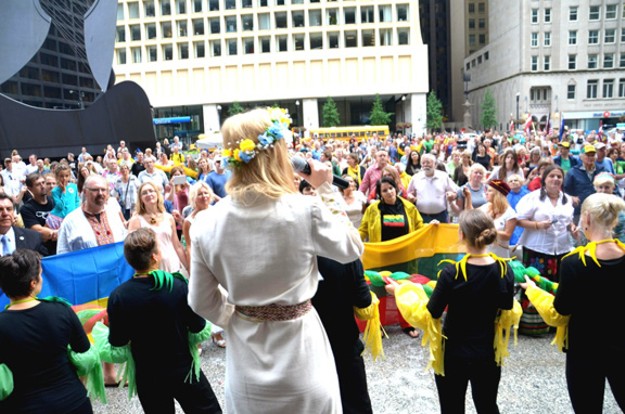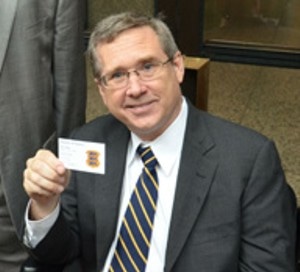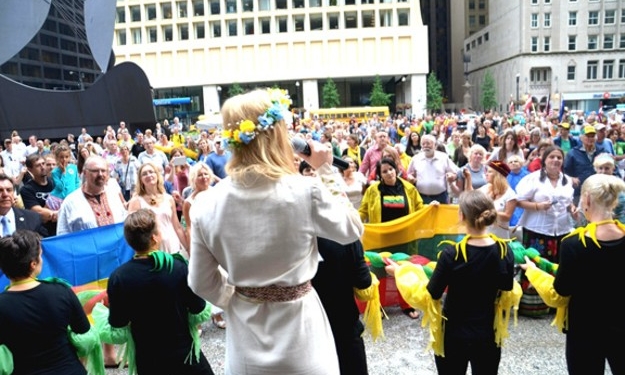
On August 23rd over a thousand people filled Chicago’s City Hall Plaza in anticipation of replicating the 400-mile long human chain that has become known as the Baltic Way and to remember the secret Molotov-Ribbentrop Pact.
Due to heavy rain, after more than an hour’s delay, we were honored by stirring remarks by U.S. Senator Mark Kirk of Illinois as he adamantly reiterated the U.S. commitment to upholding NATO’s Article 5 that states “an armed attack against one or more of them in Europe or North America shall be considered an attack against them all.” He also reminded us that the United States has “boots on the ground” in the Baltics (including Estonia).
 U.S. Senator Mark Kirk of Illinois
U.S. Senator Mark Kirk of Illinois
He was followed by U.S. Congressman John Shimkus of Illinois who arrived directly from Washington where he participated in a Black Ribbon Day memorial in the morning. Congressman Shimkus is the sponsor of the House Black Ribbon Day resolution (HR302). Following remarks by the Latvian Ambassador Razans and the Lithuanian Ambassador Pavilionis, Honorary Consul Eric Harkna represented Estonia (higher level Estonian dignitaries were in Estonia). Harkna reminded us of the significance of the remembrance and that “by the end of World War II, before the Iron Curtain was sealed, over 120,000 Baltic people were embraced into the United States” and “it is up to each of us to safeguard that precious peace, democracy and, above all, freedom”.
Each Baltic republic arranged for entertainment that culminated in the holding of hands and embracing freedom. There was even a very moving song by a Ukrainian singer. The scheduled program began with Kristi Roosmaa singing two traditional folk songs followed by Leo Rado singing Vaikne Õhtu, a song by Vinter that he discovered while browsing through a vintage music store in Tallinn. They were accompanied at the keyboard by concert pianist George Radosavljevic whose mother studied voice in Pärnu under Klaudia Taev. George also provided keyboard music throughout the day. Leo won third place in the most recent internationally prestigious Klaudia Taev Competition. Leo has both a bachelor’s and master’s degree from Julliard and is well known in the Chicago music scene. His performance clearly showed his exceptional voice training. One amateur critic who is well versed in music commented about his outstanding voice. For Leo the day was especially memorable by marking his own first quarter century, being born on the very day of the Baltic Way.
Kristi concluded the Estonian music segment by singing Eestlane olen ja eestlaseks jään. Waving an Estonian flag in one hand and holding the microphone in the other she gave an unforgettable performance that invoked both tears and joy. It was in keeping with her skills on display at previous solo performances at Carnegie Hall. By the time she was finished it was obvious to the entire audience that this would be a hard act to follow. The Estonian contingent could not have been more proud.
The afternoon continued with singing performances by renowned artists Algirdas Kaušpėdas (Lithuania) and Armands Birkens (Latvia). The Lithuanian song ensemble Dainava, the Lithuanian folk dance groups Suktinis and DanceDuo also performed. The rally concluded by joining hands and singing the legendary song Ärgake Baltimaad (Baltics Awake). We thus remembered the Baltic Way and showed our solidarity with all nations striving for freedom and independence, particularly Ukraine.
Largely attributable to the intense wind and rain delay the program ended two hours behind schedule. During the rain participants took shelter in the lobby of the Daley Center (city hall) where a preview of the 70th anniversary of Baltic Displaced Persons exhibit was on display. The exhibit was formally opened the following day and the traveling elements will be on display at various venues in Chicago, Washington and New York before the exhibit ends in late 2015. More information on the DP exhibit may be found at http://www.balzekasmuseum.org/Pages/displaced_persons.html
Readers who are DPs are encouraged to visit the web site and add their experiences by completing the “DP Project Questionnaire.”
While the crowd would have been larger had if the weather cooperated, the huge turnout was partly fueled by media coverage. One of the Chicago radio stations promoted the event and described the original event as “one of the most innovative ways to protest against a repressive government.” While the original Baltic Way was a form of protest, the commemoration in Chicago was a celebration of the freedoms that have been achieved on both sides of the Atlantic and to acknowledge the warm welcome extended by the people and the government of the United States when they opened their doors to a large-scale immigration from the Baltic Republics.
The Baltic Republics are indeed a living symbol of how to achieve independence and a more humane way of life through prudent and skillful means and by minimizing bloodshed. Today the world is witnessing too much strife and turmoil. We cannot be more humbled by the achievements of all those that were involved in bringing about the restoration of independence through fundamentally peaceful means. This achievement is more than worthy of the commemoration held on August 23rd.
Text by Siim Sööt and
Eric Harkna













